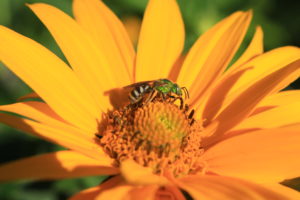One thing I will suggest, if you’re interested in keeping costs down and helping the planet: Rake the lawn but let the leaves stay in the garden beds.
Rake everything off the grass because leaves may smother grass, but in the other areas let the leaves stay. The perennials you’ve got there aren’t likely to be hindered by a few leaves.

Shredded leaves keep soil in place, add nutrients to the soil and make a great, soft path material to keep weeds down. You can even alternate leaf-variety for patterns.
Lots of beneficial insects live there (including some butterflies and native bees), the leaves are free fertilizer (they break down to provide nutrients) and a free, sustainable and renewable mulch (to help maintain moisture in the soil).
The cost of leaving them there is $0 and leaving them there requires no emissions from blowers, production of yard waste bags, the trucks to bring the leaves elsewhere, etc.
If you want a more refined option, you can shred the leaves you find on the lawn (with a lawn mower or leaf shredder) and spread those on top of the leaves in the garden. Shredded leaves do not blow around. This option requires someone with a mower to just go over your lawn to capture all the leaves and dump them – not terribly expensive and something you can probably do yourself, or someone with a rake and a shredder.
What you’re now left with are a few fallen sticks and maybe a few items that need trimming. I’m happy to do that or better yet, show you how to trim properly so you can do it yourself in future years.
What would you add to that list?


Also you can make beautiful leaf mould in an old sack with spent coffee grounds from your local barista. Two types of materials that may have gone to landfill now blended to make a soil enriching amendment.,
That’s a good option but two things to keep in mind:
1. Once you add the used coffee grounds (UCG), it is no longer “leaf mould” you’re making, it is compost. The UCG is high in nitrogen, so by adding it you’re creating the proper ratio to decompose the leaves. Both are good, but,
2. Pulling up the leaves destroys environments for some species and removes valuable mulch that protects them and the roots of plants. On the lawn, removing leaves is the right thing to do, assuming you want to keep the lawn. In flower and other gardens, those leaves are doing great work right where they are and helping the critters you want.
I know that in many places, especially on your side of the pond, people go to the woods to collect leaves for their compost and to make leaf mould. Everything within limits, but in the US that’s frowned upon both because we’re not supposed to take materials from public lands without permits and because of the damage it can create to habitats.
However, I don’t want to overstate that. Do I think a few people taking a few bags of leaves is a big issue? No. Do I think that taking leaves is on par with drilling for oil or large-herd cattle grazing, both of which are allowed? No. At some point, however, it does become an issue and one that is easily avoided by simply using other carbon-rich materials widely available in our compost, such as newspaper, plain cardboard, tissues, etc.
Thanks Jeremy,
I completely agree with everything you say.
I should have added that I live in an urban area and most of the leaves I collect have accumulated in public alleys and car parks where they simply turn to slush and become trip hazards. I therefore believe I am re-homing them and preventing a wasteful end to their existence.
Best wishes,
Fred